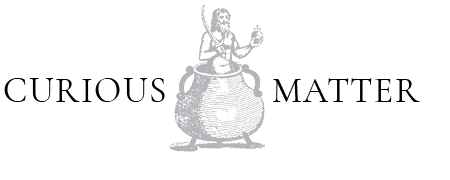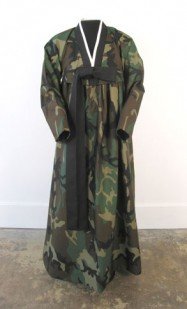Aesthetic Insubordination
March 10 – April 14, 2013
OPENING RECEPTION, SUNDAY, MARCH 10, 2013 FROM 3 TO 6PM.
Jessica Braiterman, Aurora, 2008-2010, buttons and wire, size variable
Elizabeth Morisette, Platelet, 2007. Plastic rings woven with cotton fabric on a cotton warp, 40 X 27 inches.
Donnna Stack, Military Hanbok, 2007, Woodland camouflage, linen, lining, dimensions variable
“ Your house is just a place to keep your stuff while you go out and get more stuff.
–George Carlin
IN MANY WAYS, no one can accuse the human race of idle hands. We’ve left the things we make on every part of the world, and even in outer space. In our life we are surrounded by material things. Unique to our modern life we’ve even created our own materials in the way of plastics that will be around long after we’re gone. Considering the things around us, the idea of being an artist and putting out more “stuff” in a stuff-clogged world seems ridiculous. The artists in Aesthetic Insubordination respond to this mountain of stuff by hijacking the materials and letting these things become the inspiration for their work. The uninspiring things we encounter in our daily lives, and in fact toss out and disregard, get elevated and imbued with meaning. These artists find the beauty in these average things, and treat them with the reverence in the way a painter might treat paint or a sculptor might treat marble. The artists in this show are sculptors who don’t sculpt traditionally, they stretch canvas but not for painting, or sew clothing not to wear. They approach their work in the way Eva Hesse or Ann Hamilton did before them, boldly branching away from the traditions of art making to create new pieces with new narratives that are sometimes hard to categorize.
Most of the artists in this show choose to use the materials for their work in a very labor-intensive way. Elizabeth Morisette and Jessica Braiterman use everyday materials to reference the body and forms in nature. Morisette references the body with her pieces Platelets and Villis. With Platelets she uses plastic binders to represent the platelets in our blood stream. She also makes Villis using pages from texts, suggesting how we digest information in the same way we would digest food. Jessica Braiterman uses hundreds of different kinds of buttons and wire to represent a natural occurrence. From far away all the buttons function together to form a unified piece but the closer one gets to the piece, the more the individual details of the different kinds of buttons become evident. This reminds me of scientific exploration, and how the true nature of what something is and composed of becomes more evident with closer examination.
Susan Noyes also works in this same vein, as masses of individual pieces work together to create one piece. Her work is both threatening and beautiful. She takes different kinds of x-acto blades and creates elaborate patterns, like ones you might expect to see in tile designs or traditional quilt patterns. It is also interesting to me that she uses something that someone might use to cut patterns to actually make the patterns themselves. She is using an art tool as art, in the same way Jasper Johns used his own paint brushes in his assemblages.
Donna Stack and Zofie Lang work narratives into their work that deals with identity and folklore. Donna Stack’s work deals with her dual identities of being both Korean and Southern American. She creates two traditional Korean Hanboks, one in military camouflage and the other in flannel. The camouflage hanbok references the military tension in the Korean peninsula and the flannel hanbok relates to her life as a southerner, flannel being a common type shirt worn in the south. Zofie Lang uses traditional fairy and folk tales as the foundation for her work, giving them a contemporary meaning. With her background in psychology, she sees the tales as a way for man to make sense of the world and to deal with life’s uncertainty. She believes even some of the old tales have validity in modern times, and that there is still much to learn from them.
One might suggest that art is just more stuff, but to me it is far more than that. It is the forum where we investigate the world, seek meaning, and work out our place in the universe. It is also a celebration of human creativity and inquiry. All these artists work in somewhat similar ways but the end results vary greatly. So, to put it simply, these artists make some really cool stuff.
Travis Childers, curator
.
A NOTE FROM THE CO-FOUNDERS
There is something utterly uplifting in the way this emotionally needful and fragile young woman coped with emotional chaos by reinventing sculpture through aesthetic insubordination, playing with worthless material amid the industrial ruins of a defeated nation…. –Arthur C. Danto on Eva Hesse, “All About Eva”, The Nation, July 17, 2007
TRAVIS CHILDERS IS AN ALCHEMIST. By transmuting the mundane elements from our daily lives he creates, via bricolage, the gold of art. Whether the plastic pen caps of Hive, the grains of rice for Riceworld or the playful and startling use of Silly PuttyTM in his piece Culture, Childers transcends the physical and visual limitations of his source material. He invents new objects that absorb the identity of the units of their construction to take on a new form. There is more than the creative vision at work in his art. There is also a sustained and dexterous physical manipulation of the chosen medium, as well as an intimate understanding of its limitations using a Postminimalist context. By incorporating the hand of the artist with the seriality of the modular, he is able to transcend the humble functionality of his media.
With Aesthetic Insubordination, he has brought to Curious Matter a group of like-minded artists who are all intensely willing to do the work; to put their hands to the task. They, like Childers, take meaningless “stuff” and transmute it into something meaningful. Through their aesthetic insubordination–their acts of using unsanctioned art materials and methods to make art–they refine what is unrefined. It is difficult in these Postmodern days of artistic pluralism to define any artist as being insubordinate. Many are experimenting with a range of media, from emptiness to everything, in an effort to make their mark. Travis Childers has applied his alchemist touch to the selection of these five artists whose aesthetic gifts transcend any insubordination. To look at the work of the artists in this show is to understand the power of the artist’s hand to transform. Not like the magician whose sleight of hand is facile, but more like the alchemist who works and refines for years–a lifetime perhaps–until the right method and formula combine, and that which is sought appears.
Raymond E. Mingst • Arthur Bruso
co-founders, Curious Matter
.
Travis Childers was born in Nashville, TN. Childers is a mixed-media artist with an MFA from the Maryland Institute College of Art, Baltimore, MD and a BFA from Austin Peay State University, Clarksville, TN. He has shown both nationally and internationally at such spaces as Rare Gallery and Benrimon Gallery in New York, NY and The Porthole Space in London, England. Childers currently lives in Fairfax, VA .
The Artists
Jessica Braiterman
Zofie Lang
Elizabeth Morisette
Susan Noyes
Donna Stack
Curated by
Travis Childers



